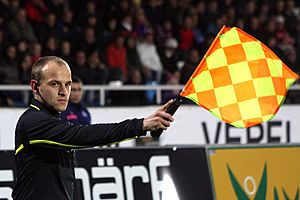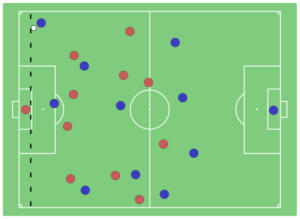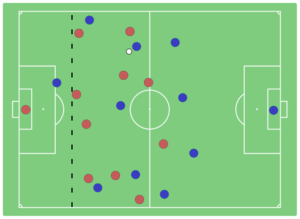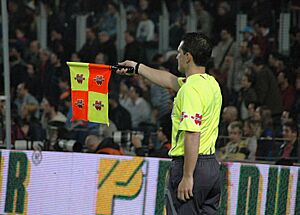Offside (association football) facts for kids

Offside is an important rule in association football, also known as soccer. It's part of Law 11 of the Laws of the Game. This rule helps make the game fair and exciting. It stops players from just waiting near the opponent's goal to score easily.
A player is in an offside position if they are closer to the opponent's goal line than both the ball and the second-last opponent. This must happen in the opponent's half of the field. Your hands and arms don't count for this rule. Usually, the goalkeeper is the last opponent, but not always.
Just being in an offside position is not against the rules. It only becomes an offside offence if you get involved in the play. This means if you touch the ball, bother an opponent, or get an unfair advantage. Offside can be tricky to understand, even for grown-ups!
Contents
What is Offside?
The offside rule is judged the moment a teammate touches or plays the ball. If you are in an offside position at that exact moment, you could be called offside. But only if you then become "involved in active play."
When an offside offence happens, the referee stops the game. The other team gets an indirect free kick. This kick is taken from where the player committed the offside offence.
Being offside is not a "foul" like tripping someone. But if you score a goal after an offside offence, the goal won't count. Sometimes, a player might get a yellow card for trying to trick the referee about offside. This is for unsporting behavior, not for being offside itself.
Attackers who get behind defenders are often in a great spot to score. The offside rule limits this. It makes sure attackers are "onside" when the ball is passed forward. Good timing and fast running let players get into scoring positions *after* the ball is kicked.
Decisions about offside can be very close. Sometimes it's only by a few centimeters! These calls can change the game, deciding if an attack continues or if a goal counts.
Assistant referees, also called linesmen, help the main referee with offside calls. They stand on the sidelines to get a good view across the field. They raise a flag to signal offside. But the final decision is always up to the main referee.
How the Offside Rule Works
Understanding offside involves three main parts: being in an offside position, committing an offside offence, and the punishment for it.
Offside Position

You are in an "offside position" if two things are true:
- Any part of your head, body, or feet is in the opponent's half of the field. The halfway line itself doesn't count.
- Any part of your head, body, or feet is closer to the opponent's goal line than both the ball and the second-last opponent.
Remember, your hands and arms don't count for this rule. The goalkeeper is an opponent. But the second-last opponent doesn't have to be the goalie.
Offside Offence
You are only penalized for an offside offence if you were in an offside position when a teammate touched the ball AND you then get involved in the play. This means:
- Playing or touching the ball that a teammate passed or touched.
- Stopping an opponent from playing the ball. This could be by blocking their view or challenging them for the ball.
- Trying to play a ball that is close to you, and this affects an opponent.
- Making a clear action that stops an opponent from playing the ball.
- Getting the ball after it bounced off the goalpost, crossbar, a referee, or an opponent.
- Getting the ball after an opponent deliberately saved it. A "save" means stopping a ball going into or near the goal with any part of the body (except hands/arms, unless it's the goalkeeper in their penalty area).
There is NO offside offence if you get the ball directly from a goal kick, a corner kick, or a throw-in. Also, it's not an offence if an opponent deliberately played the ball last (unless it was a save).
You *can* be offside from a direct free kick, indirect free kick, or dropped-ball.
Since offside is judged when the ball is *played* by a teammate, you can run into an offside position *after* the ball is kicked. As long as you were onside when the ball was played, you are fine.
If you were offside when your teammate played the ball, but then another player (who was onside) plays the ball, the offside situation "resets." You are no longer liable for the original offside offence.
Offside Sanction
If an offside offence happens, the other team gets an indirect free kick. This kick is taken from where the offside player became involved in the game. It can even be in the player's own half of the field.
Officiating Offside
The referee relies a lot on the assistant referee for offside calls. The assistant referee usually stays in line with the second-last opponent, the ball, or the halfway line, whichever is closest to the goal.
When an assistant referee sees an offside offence, they first raise their flag straight up. If the referee stops play, they then lower their flag to an angle to show where the offence happened:
- Flag pointed 45 degrees downwards: Offence was in the third of the field closest to the assistant referee.
- Flag parallel to the ground: Offence was in the middle third of the field.
- Flag pointed 45 degrees upwards: Offence was in the third of the field furthest from the assistant referee.
Judging offside is very hard! Assistant referees must keep up with fast play. They need to see who is offside when the ball is played, and then decide if that player gets involved. Players can move very quickly, making it tough to judge if they are level with a defender at the exact moment the ball is kicked.
Why Do We Have Offside?
The offside rule was created to stop players from "goal-hanging." This means standing near the opponent's goal and just waiting for the ball to be passed to them. People thought this was unfair and made the game boring.
The offside rule makes players stay behind the ball. This encourages more dribbling and short passes, rather than just long passes over the top. It helps keep the game flowing and exciting.
History of Offside
The idea of offside has been around for a long time. Early forms of football in the 1800s had similar rules.
Early Rules (Before 1863)
Many early school and university football rules had "strict" offside laws. This meant any player ahead of the ball was offside. This is similar to how offside works in rugby today.
Some schools, like Eton and Cambridge, had a "rule of four." This meant you were only offside if there were fewer than four opponents between you and their goal.
Clubs like Sheffield Football Club didn't have an offside rule at first. They had players called "kick-throughs" who stayed near the opponent's goal.
The First FA Laws (1863)
When the Football Association (FA) was formed in 1863, they created the first official laws of football. Their first offside rule was very strict. It said a player was "out of play" if they were in front of the ball. They had to go behind the ball as soon as possible.
Changes Over Time
- Three-player rule (1866): This was a big change. It said a player was only offside if there were *fewer than three* opponents between them and the goal. This made it easier for attackers.
- Offside in own half (1907): Before 1907, you could be offside even in your own half! This rule changed so you could only be offside in the opponent's half.
- Two-player rule (1925): The rule changed again, making it even easier for attackers. Now, you were only offside if there were *fewer than two* opponents between you and the goal. This led to many more goals being scored and changed how teams played.
- Attacker level with second-last defender (1990): This rule made it clear: if an attacker is level with the second-last defender, they are *onside*. This was done to help attacking teams.
- Parts of body (2005): The rules clarified that only the head, body, or feet count for offside. Hands and arms don't count.
- Halfway line (2016): It was made clear that a player on the halfway line itself cannot be offside. You must be in the opponent's half to be offside.
Exceptions to Offside
The offside rule doesn't apply to all restarts of play:
- Goal kick: You cannot be offside from a goal kick.
- Throw-in: Since 1920, you cannot be offside from a throw-in.
- Corner kick: Since 1883, you cannot be offside from a corner kick.
- Free kick: You *can* be offside from a free kick. This is different from the other restarts.
Offside Trap
The offside trap is a defensive trick. Defenders try to make attacking players offside on purpose. Just before an opponent passes the ball forward, the defenders quickly move up the field. This leaves the attacker in an offside position.
This tactic needs perfect timing from the defenders. It's risky because if they get it wrong, the goal can be left open. With newer rules, it's harder to "trap" players. This is because a player isn't offside unless they are directly involved in the play. An attacker might just avoid the ball if they realize they are offside.
Famous coaches like Arrigo Sacchi and Jürgen Klopp have used the offside trap effectively. For example, Liverpool F.C. under Jürgen Klopp used a high defensive line and quick defenders to catch many opponents offside.



